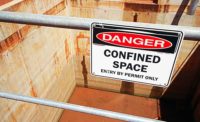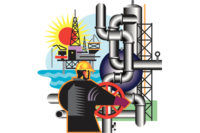The dangers lurking within confined spaces are well documented, with horror stories that often recount the tragic outcomes of routine maintenance gone awry. When an individual inside a confined space becomes unresponsive and a "hole watch" rushes in to assist, only to be overcome by the same lethal gas, we are reminded of the critical importance of adhering to proper safety protocols. OSHA estimates that confined spaces are responsible for about 200 deaths each year, and around 60 percent of which are would-be rescuers — people who, driven by instinct to aid a colleague, become victims themselves.
It's imperative that all workers receive thorough training before undertaking tasks in or around confined spaces. However, the reality is that not all work is executed under ideal conditions, nor is there always comprehensive knowledge of the potential gas hazards present.
To combat these real-world dangers, advancements in gas detection technology, such as area monitors equipped with enhanced communication capabilities, have been developed. These technological innovations are designed to ensure that alarms are not only audible and visible, but also provide clear information on the location and cause of the alarm. With the goal of reducing the number of would-be rescuer fatalities and unnecessary evacuations, these tools also enable a swifter emergency response from trained peers on-site, rather than depending on distant central controllers.
Managing gas hazards with peer-to-peer communications
Traditionally, atmospheric testing within confined spaces has been conducted solely using handheld portable instruments. However, the introduction of area monitors with peer-to-peer wireless technology has the potential to significantly boost the efficiency and safety of operations requiring extended, continuous monitoring.
A peer-to-peer communication network wirelessly connects area monitors to personal gas monitors, enhancing worker safety by sharing real-time alarms and gas readings among connected devices. This network allows an attendant, like our "hole watch," to understand why a partner has become unresponsive without risking exposure themselves. Notably, peer-to-peer communications operate independently of external networks like cellular or satellite, ensuring reliable communication even within confined spaces.
When it comes to monitoring multiple confined spaces, area monitors with peer-to-peer wireless capabilities shine. OSHA standards permit attendants to monitor several confined spaces simultaneously, given that they can effectively perform their duties for each space. Area monitors that feature large displays, clear alarms, and long run times can not only meet but exceed regulatory requirements. Adding wireless communication heightens the effectiveness and efficiency of safety protocols, allowing attendants to receive gas readings and alarm notifications from any connected instrument, thereby knowing precisely where an issue arises without being physically present.
This technology closes the gap for less experienced or untrained workers, as the area monitor communicates hazards loudly and clearly, reducing ambiguity and the need for interpretation. Different tones and flashing colors signify varying levels of alarms, ensuring the attendant can differentiate between high alarms, low alarms, and maintenance reminders.
Real-time area monitoring, particularly when integrated with a cloud-based platform, offers a comprehensive view of environmental conditions, advanced warnings, and quicker reaction capabilities. Constant data availability empowers management with the insights needed to enhance job safety.
Improving your confined space entry plan
Despite the necessity for workers to enter confined spaces, the hazards they face must be carefully managed. A safe confined space monitoring strategy is a collaborative effort, requiring supervisors to ensure that workers are aware of the hazards, possess the necessary safety and communication tools, and receive proper training.
To manage gas hazards in confined spaces effectively, supervisors should:
- Plan: Complete risk and hazard assessments, determine required personal protective equipment, and select trained workers for the job.
- Test Atmosphere: Use gas monitors with remote sampling pumps for pre-entry testing and continuous monitoring during entry. This can include both personal gas monitors and portable area monitors.
- Communicate: Ensure attendants monitor and maintain communication with entrants in all confined spaces. By implementing peer-to-peer communication, you can automatically share gas readings and alarms, so all workers know when a peer needs help and what conditions they’re facing.
Ultimately, preventing tragedies associated with confined space work hinges on the use of gas detectors that can automatically share readings and alarms, informing all workers when assistance is needed and under what conditions.
For those responsible for managing confined spaces, it is crucial to regularly evaluate and update safety procedures to ensure they effectively alert workers to gas hazards. Consulting with gas detection experts can help in reviewing and improving your gas detection program, reinforcing your commitment to worker safety.



